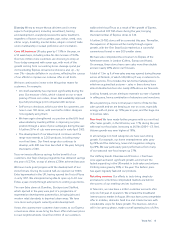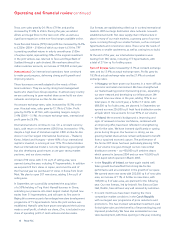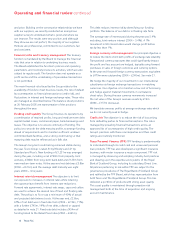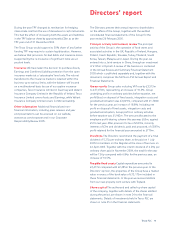Tesco 2005 Annual Report Download - page 10
Download and view the complete annual report
Please find page 10 of the 2005 Tesco annual report below. You can navigate through the pages in the report by either clicking on the pages listed below, or by using the keyword search tool below to find specific information within the annual report.8Tesco PLC
Operating and financial review continued
and price. Building on the constructive relationships we have
with our suppliers, we recently conducted an anonymous
supplier survey to understand what is good and where we
can improve. The results were very positive, and although
they show we are not perfect, the majority of our suppliers
think we are professional, committed to our customers, fair
and consistent.
Financial risks and treasury management The treasury
function is mandated by the Board to manage the financial
risks that arise in relation to underlying business needs.
The Board establishes the function’s policies and operating
parameters, and routinely reviews its activities, which are also
subject to regular audit. The function does not operate as a
profit centre and the undertaking of speculative transactions
is not permitted.
The main financial risks faced by the Group relate to the
availability of funds to meet business needs, the risk of default
by counterparties to financial transactions (credit risk), and
fluctuations in interest and foreign exchange rates. These risks
are managed as described below. The balance sheet positions
at 26 February 2005 are representative of the positions
throughout the year.
Funding and liquidity The Group finances its operations by
a combination of retained profits, long and medium-term debt
capital market issues, commercial paper, bank borrowings and
leases. The objective is to ensure continuity of funding. The
policy is to smooth the debt maturity profile, to arrange funding
ahead of requirements and to maintain sufficient undrawn
committed bank facilities, and a strong credit rating so that
maturing debt may be refinanced as it falls due.
The Group’s long-term credit rating remained stable during
the year. Tesco Group is rated A1 by Moody’s and A+ by
Standard and Poor’s. New funding of £1,231m was arranged
during the year, including a net £740m from property Joint
ventures, £368m from long-term bank debt and £123m from
new medium-term notes. At the year end net debt was £3.8bn
(2004 – £4.1bn) and the average debt maturity was eight
years (2004 – nine years).
Interest rate risk management The objective is to limit
our exposure to increases in interest rates while retaining
the opportunity to benefit from interest rate reductions.
Forward rate agreements, interest rate swaps, caps and collars
are used to achieve the desired mix of fixed and floating rate
debt. The policy is to fix or cap a minimum of 40% of actual
and projected debt interest costs. At the year end, £2.6bn,
67% of net debt was in fixed rate form (2004 – £2.9bn, 71%)
with a further £745m, 19% of net debt, collared or capped
as detailed in note 21. Fixed rate debt includes £454m of
funding linked to the Retail Price Index (2004 – £441m).
This debt reduces interest risk by diversifying our funding
portfolio. The balance of our debt is in floating rate form.
The average rate of interest paid during the year was 5.4%
excluding Joint venture interest (2004 – 5.4%). A 1%
movement in UK interest rates would change profit before
tax by less than 1%.
Foreign currency risk management Our principal objective is
to reduce the risk to short-term profits of exchange rate volatility.
Transactional currency exposures that could significantly impact
the profit and loss account are hedged, typically using forward
purchases or sales of foreign currencies and currency options.
At the year end forward foreign currency transactions equivalent
to £479m were outstanding (2004 – £240m). See note 21.
We hedge the majority of our investment in our international
subsidiaries via foreign exchange transactions in matching
currencies. Our objective is to maintain a low cost of borrowing
and hedge against material movements in our balance
sheet value. During the year currency movements increased
the net value of the Group’s overseas assets by £19m
(2004 – £157m decrease).
We translate overseas profits at average exchange rates which
we do not currently seek to hedge.
Credit risk The objective is to reduce the risk of loss arising
from default by parties to financial transactions. The risk is
managed by spreading financial transactions across an
approved list of counterparties of high credit quality. The
Group’s positions with these counterparties and their credit
ratings are routinely monitored.
Tesco Personal Finance (TPF) TPF lending is predominantly
to individuals through its credit card and unsecured personal
loan products. TPF has also developed a significant insurance
business, with motor insurance a major component. TPF risk
is managed by observing and adopting industry best practices
and drawing upon the expertise and systems of the Royal
Bank of Scotland Group, including its subsidiary, Direct Line.
All policies pertaining to risk within TPF are subject to the
governance procedures of The Royal Bank of Scotland Group
and ratified by the TPF Board, which has representation from
both Tesco and The Royal Bank of Scotland Group. This has
delivered a portfolio of products with strong asset quality.
This asset quality is maintained through proactive risk
management both at the time of acquisition and ongoing
account maintenance.























